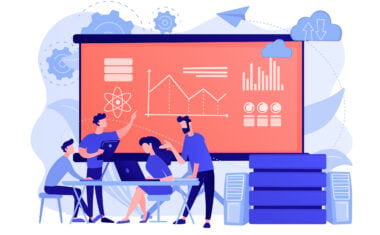To have a successful career in future technologies like data science, machine learning (ML), and analytics, you need a combination of two complementary skill sets: An instinctive understanding of data and practical expertise with relevant tools. While developing an instinctive understanding of data will be a long-term and immersive endeavor, you can begin playing with machine learning tools right away. Here are some tools that we recommend you begin with. We’ve kept them all open-source to help you not only try your hand at them for free but also tap into the large global community for support.
Machine learning tools: Programming languages
Python: Full-feature language for beginner’s needs
Even though Python was designed—and is used—as a general-purpose programming language, today, it’s the most popular language for machine learning data analyze and data science. Native data scientists favor Python because it’s minimalistic, intuitive, readable,
and has a vast repository of libraries for specific purposes.
For instance, Instacart, the $8B online grocery retailer uses Python for demand forecasting. The most common application areas for Python tend to be in sentiment analysis, quantitative trading, chatbots, web mining, etc.
R: Must have data analysis tool in the statistician’s armor
R is a statistical computing language, favored by data analysts and statisticians, who are making their way into the world of ML. While Python, known for its predictive accuracy, is more popular in artificial intelligence (AI) circles, R, with its strengths in statistical inference, remains a data analyst’s Mjolnir!
R is used in fraud detection and other such use cases in the financial sector; in fact, Bank of America uses R for financial modelling. A former Facebook data scientist Paul Butler built his famous Facebook map of the world with R.
Choosing between Python and R is a matter of finding the right application for the language you’re using. More often than not, companies use both Python and R.
Machine learning tools: Libraries and frameworks
TensorFlow: Machine learning at scale
Tensor flow is a computational framework for building machine learning models. The GoogleBrain team developed TensorFlow for their internal use and continue to use it for research and production across its products, giving it the credibility of delivering ML at scale.
The biggest use cases of TensorFlow tend to be in Image recognition, text classification, and natural language processing. In fact, GE uses TensorFlow to identify the anatomy of the brain in MRIs.
Scikit-learn: For a wide range of applications
Scikit-learn is a multi-purpose Python library, used primarily for data mining and analysis. It can be used across supervised and unsupervised algorithms for use cases in classification, regression, clustering, pre-processing and model selection.
Scikit-learn is favored by those working in spam detection, image recognition, text classification, etc.
Weka: Simplifying ML with a GUI
The biggest differentiator for Weka, a rather uncommon machine learning tool, is its graphical user interface (GUI). It accelerates the learning curve of those who aren’t confident of their coding skills, while also allowing confident programmers to call the Java library, as they need.
Weka is popular for data mining and exploration tasks such as pre-processing, classification, association, regression, clustering, and visualization.
Deep learning machine learning tools
Keras: Prototyping at lightning speeds
After TensorFlow — which we consider an all-purpose ML tool, and not a specialized deep learning tool — Keras is the second most popular framework, across evaluation criteria, finds Jeff Hale, Data Scientist, Author and COO at Rebel Desk.
Keras is a cross-platform open-source neural network library, written in Python. It was built to enable easy, fast, and convenient deployment of deep learning models — so, it’s modular, minimal, extensible and Python-driven.
PyTorch: Flexible and modular framework for AI / ML research
Developed by the AI research team at Facebook, PyTorch is an open-source library for use cases in computer vision and natural language processing. It boasts of the ability to expedite experimentation to move models swiftly to production, with its user-friendly interface — both Python and C++ interfaces — distributed training and extensive range of tools.
PyTorch works best for use cases such as handwritten recognition, object image, and sentiment text classification. But Caltech uses PyTorch for their neural lander project that models the aerodynamics of how a drone interacts with the ground!
Get To Know Other Data Science Students
George Mendoza
Lead Solutions Manager at Hypergiant
Jasmine Kyung
Senior Operations Engineer at Raytheon Technologies
Leoman Momoh
Senior Data Engineer at Enterprise Products
Analytical tools
Apache Spark: Analytics engine for big data processing
Apache Spark is a cross-platform, open-source cluster computing framework, which is primarily used for big data analytics. The main reason developers favor Apache Spark tends to be its speed, even though, the product is also easy to use and highly-integratable across various platforms and data sources.
MapReduce: A heavy-weight in data manipulation
MapReduce is a programming model for big data processing on clusters; it’s one of the most popular algorithms for large-scale data manipulation. It is typically used for parallelizable problems across huge volumes of both structured and unstructured data.
Visualization tools
Matplotlib: Visualization with just a few lines of codes
Matplotlib is a multi-platform data visualization library, with 2D plotting capabilities. It is usable as MATLAB with Python, while also being open-source. Matplotlib can handle a range of plots such as line, scatter, contour, polar, image, 3D, histogram, etc.
Seaborn: For attractive data visualization
Based on Matplotlib, Seaborn offering a higher-level interface and customized themes for drawing visually enhanced statistical graphics. Seaborn also has the capability to accurately visualize dataframes, which Matplotlib has been known to struggle with.
Jupyter Notebook: For rich interactive output
Though traditionally used in academia as a notebook to record research, notes, computations and findings, today, the Jupyter Notebook has found its place in the data visualization realm. Programmers and ML professionals use the Jupyter Notebook across data cleansing, numerical simulation, statistical modeling, etc.
It supports over 40 programming languages and easily integrates with big data processing tools like Apache Spark.
Machine learning tools: Honorary mentions
SQL: From database to data science
The most common tool data scientists apply for extracting data from both relational and non-relational databases is SQL. Whether one is a data scientist or a data analyst, being able to write structured queries to extract data is a fundamental skill.
Hadoop: Distributed data processing at scale
Apache Hadoop is a collection of software utilities that help in the distributed processing of large volumes of data, across clusters. It breaks data into files and distributes them across nodes in a cluster — storage is handled by the Hadoop Distributed File System (HDFS) and the processing by MapReduce.
Pandas: High-performance, yet easy-to-use
Pandas is a Python software library primarily used in data analysis and manipulation of numerical tables and time series. Data scientists use Pandas for importing, cleaning and manipulating data as pre-preparation for building machine learning models. Pandas enable data scientists to perform complex data analysis workflows within Python, without having to move to a more statistically competent tool like R.
In addition to these 15 open-source tools, there are also proprietary tools such as MATLAB for numerical computing, Tableau and Power BI for visualization. Depending on the application of your ML program and the cloud environment you’re in, you might need these tools. But if you ask us, the open-source tools we’ve listed are plenty good.
Since you’re here…
Curious about a career in data science? Experiment with our free data science learning path, or join our Data Science Bootcamp, where you’ll get your tuition back if you don’t land a job after graduating. We’re confident because our courses work – check out our student success stories to get inspired.







